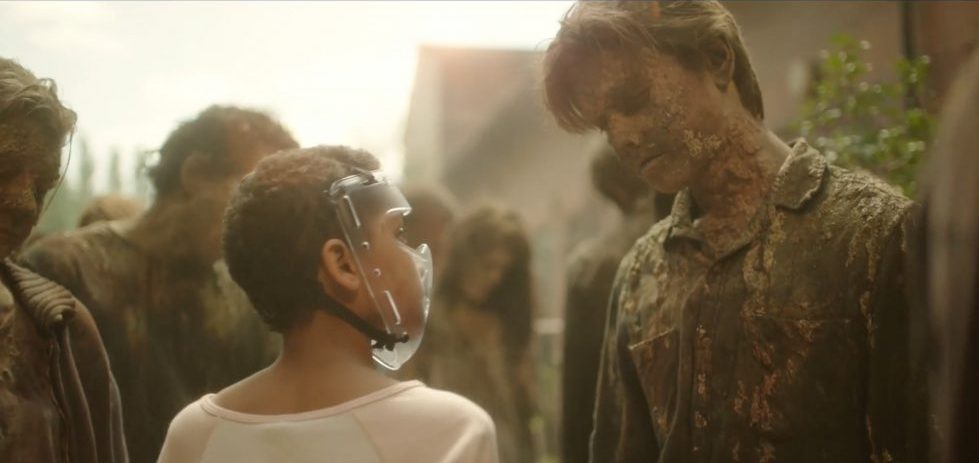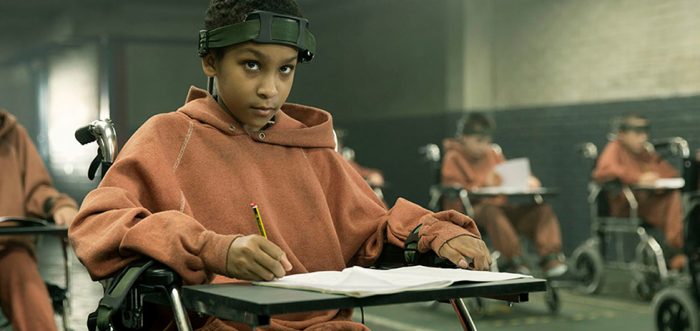
A terrible disease ravages humanity; it is contagious, and violent; it cleaves an ‘us’ from ‘them’—the monstrous infected—and pits a small and unlikely fellowship of the last-remaining into a battle for their lives and for the future. This post-apocalyptic thriller formula populates a wearying number of films from the past decade, is most impressive when the battle is not only physical but also philosophical. The Girl With All the Gifts tries for this and succeeds to a degree that marks it out from other films of the genre.
The pragmatic details—London and surrounds, a decade or so in the future, a fluid-spread fungal infection that propagates by turning the now-mindless and rabid host into a blood-crazed monster intent on savaging the healthy—are not all that important, interchangeable as they are with any other genre-bound variation. Newcomer Sennia Nanua is excellent as Melanie, an eager, bright, and deeply empathetic child who is unknowingly part of the scarcer second generation of infected “hungries”, who only become rabid when directly stimulated and otherwise retain consciousness and autonomy. Treated as an abomination by the majority of remaining “friendlies” for this reason, Melanie and her cohort are kept alive in the harshest of environments only for their potential as a scientific resource.
The film is visually strong, finding a fresh vibrance in the idea of a post-apocalyptic landscape. The crisp, and at times quite beautiful, cinematography skilfully moves between the violent and the still—Melanie has been raised in a concrete cell and now finds herself in a world she has only read about, so her perspective is an opportunity for the camera to intersperse genre-prescribed shots of stagnant decay and despair with moments of excitement and wonder at this strange, surreal environment. The powerful soundscape (courtesy of Cristobal Tapia de Veer) builds and releases tension well, but the dialogue fumbles: the dialogue trope of “quiet all of a sudden,” for example, is familiar enough when demonstrated, and really doesn’t need to be narrated by a character.
Despite this, the urban scenes that dominate the latter half of the movie are taut, and capitalise on the familiar—say, a Mercedes Benz logo—to drive home the devastation. The fungal menace has ruptured society so wholly that race no longer exists, presumably: which is convenient, or we might need to look harder at why it is a black actor (Fisayo Akinade) plays the role of Kieren, the likeable but less disciplined soldier who ultimately becomes a victim to his own inability to stay clear-headed against the fog of his physical urges and dies without having achieved significant character development, while a white actor (Paddy Considine) plays Sergeant Parks, the idealised soldier whose aggressive alpha-masculinity is balanced by the virtue of being written as a semi-complex character with a sympathetic back story. It is not the dubious racing and gendering of the supporting characters alone, though, that makes them mildly cliché. They are all characters constructed from typical traits and predictable arcs, which are reasonably satisfying nonetheless. Glenn Close plays the cold-hearted and fixated scientist, Dr Caldwell, while Considine and Gemma Arterton are the initially polar Sergeant Parks and Miss Justineau (respectively the tough aggressor-turned-protector, and the compassionate teacher).

However, the moral quandaries that lie at the heart of The Girl With All the Gifts elevate the film above its clichés. Writer Mike Carey introduced the film on Locarno’s opening night by noting that the post-apocalyptic genre is perhaps more relevant than ever before, as we collectively march closer to various doomsday scenarios. At first glance, the film adds little by the way of social commentary, despite being produced in a time when these scenarios are beginning to emerge from the mist of the future, inchoate but increasingly tangible.
For much of the runtime, it appears that the main analogy to be drawn is one about the tragedy of social contagion and the murky status of the rights of the contagious. Such a message would have been recklessly irresponsible in the current climate of the dehumanisation and ostracisation of certain social groups viewed as a contaminating threat. However, by the end it transpires that in fact the most obvious message is about change, renewal and hope—which is a fine, if limited and familiar message. Less blatant and more nuanced concepts distinguish themselves against this typical humanity-triumphs thematic. It turns out that only Melanie and the second generation are able to become the moral subjects of the future. The triumph of the second generation of the infected is them taking the place of the uninfected as the moral subjects of the future, breaking the dichotomy of ‘us’ and ‘them’. The ambiguity over who has the right to survive is far more provocative than a simple survival story: nobody, perhaps, has more right than any other.
The second point of distinction is less obvious again, and not wholly intended as a takeaway message. The post-apocalyptic genre often posits the primary horror as something separate from, and hostile to, humanity. We tend towards an urgent denial of our common capability to inflict suffering: the evil must come from others, whether that is a disease or a demonised group. If or when these scenarios do eventuate – when antibiotic resistance devastates us with diseases we thought were vanquished, when wars are fought over water, when refugees outnumber the soldiers on borders – the monstrous won’t be inhuman. The true monstrosities will be actions of both good intent and self-interest; the choices of weighted interests, about whose lives are privileged over others; the horrifying choices that we already make. The obvious candidate for what makes Melanie both a child and a monster is her capacity to cannibalise others, yet her most horrifying act is the final tragedy: an accidental outcome of acting upon the very morality that makes her “alive”, and human.
The more subtle and unsettling horrors of The Girl With All the Gifts have gravity and potential than mere shock-value zombies do not. The film is not groundbreaking, but it’s well made and directs us towards concepts that could do much to enrich the genre; towards a more nuanced vision of a future we would rather avoid.
